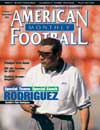AMERICAN FOOTBALL MONTHLY THE #1 RESOURCE FOR FOOTBALL COACHES
Article CategoriesAFM Magazine
|
The Clemson Zone Combo Packageby: John TurnerOffensive Assistant, Clemson University © More from this issue The Clemson Tigers offensive style of football was developed in accordance with and is a reflection of head coach Tommy Bowdenís personality. The offense was designed as an aggressive, up tempo, attacking style that continuously applies pressure to the defense. This attitude has produced one of the most balanced offensive attacks in the nation over the last four years. His teams have consistently averaged more than 190 yards, both rushing and passing, and have generated on average more than 440 yards per game. In addition to the rushing and passing statistics, his teams have also been ranked in the top 15 in point production, averaging more than 35.0 points per game over the last four years. This production has often been attributed to his ability to group plays together into a cohesive package. This package provides the offense with the....The full article can only be seen by subscribers. Subscribe today!
|
|
|||||||
| HOME |
MAGAZINE |
SUBSCRIBE | ONLINE COLUMNISTS | COACHING VIDEOS |
Copyright 2026, AmericanFootballMonthly.com
All Rights Reserved





